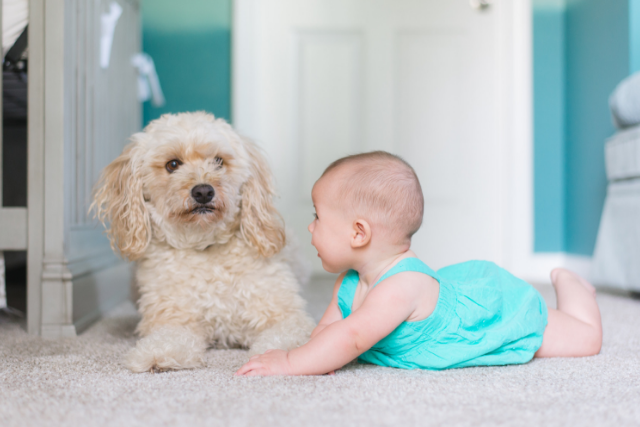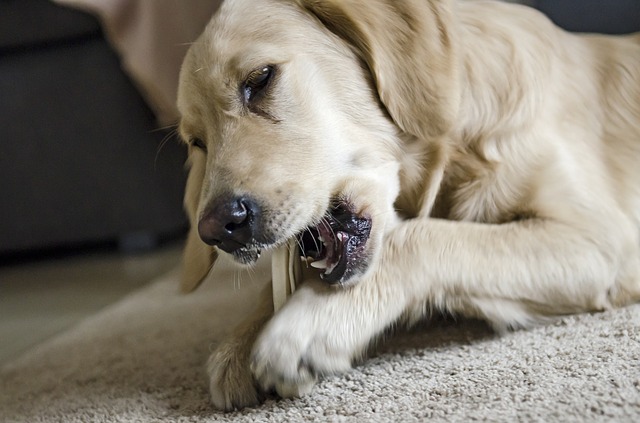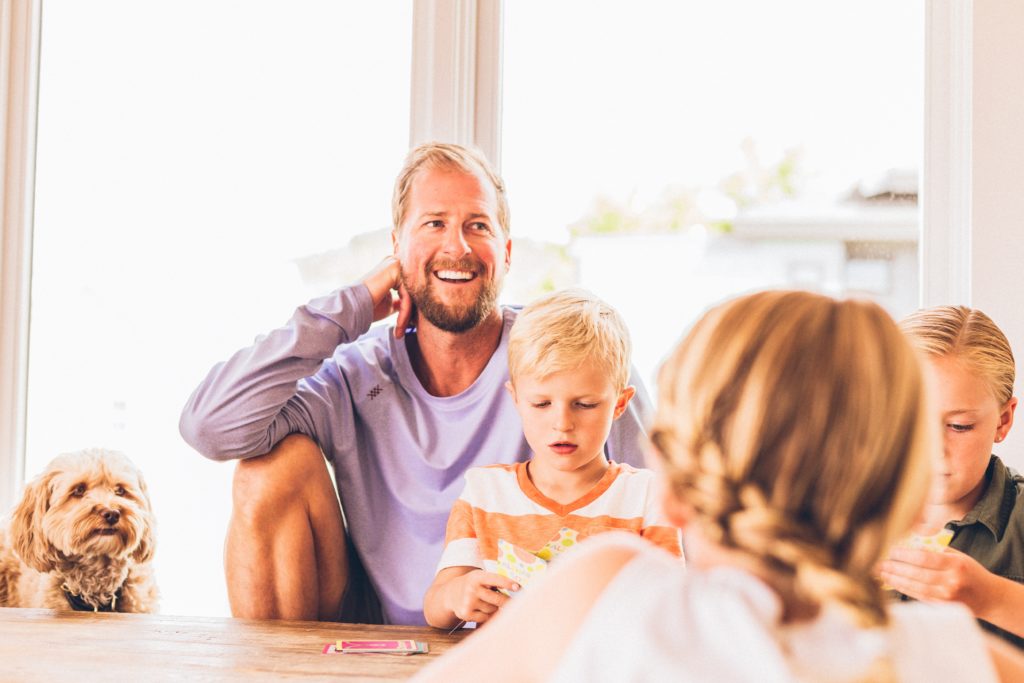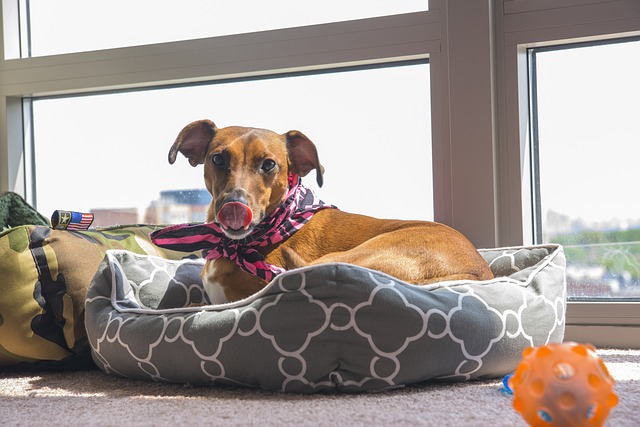Your fur baby is used to being the center of attention, but that’s all going to change once he meets the family’s newest bundle of joy. His unique personality will play a big role in how he reacts to having a human sibling, and now’s the time to start thinking about their introduction. Some dogs are nervous and afraid of tiny humans, and others are overly excited about meeting a new friend. Either way, how you introduce a dog to baby matters. You can help ease your pup’s transition from only child to eldest sibling by following this eight-step plan.

Before Baby’s Arrival
1. Focus on Obedience Training
Obedience training will benefit your dog no matter what kind of situation they face. It helps them learn self-control and gives you peace of mind. If you’re not 100% confident in your ability to control your dog with only your voice, it’s a good idea to use the months before baby to brush up on basic obedience.
Knowing cues including “sit,” “stay,” and “settle,” will make life easier for both you and your dog. You can also teach him “go to your mat” or “go to your crate” to keep him out from underfoot in stressful situations. The “drop-it” and “leave it” cues will be useful when your dog discovers things like baby toys and used diapers.
2. Make Rule Changes Early
Whether your dog likes it or not, a new baby will mean new rules. To make these changes as easy to accept as possible, start teaching your pup the new ways of doing things early on. You have somewhere around nine months to prepare your pup, and there’s no such thing as starting too early.
If you plan on having the nursery off limits, for example, start enforcing that rule long before baby sets up occupancy. You don’t want your dog associating the baby with these potentially discouraging rule changes. As long as the rule is in place long before baby arrives, he won’t make any negative connections.

3. Give Them Time to Adjust to New Routines
While the whole family figures out what the new “normal” is, your dog will most likely have to sacrifice certain parts of his daily schedule. If he’s used to going on a walk at the same time every day, that might not happen anymore.
Abruptly changing the routine the day baby is born won’t bode well for your dog. He want to resist the sudden change, and he’ll know to blame the babe. ASPCA advises pet parents,
“Many dogs experience anxiety when their lifestyles are drastically altered. Although things will change with the arrival of your new baby, you can minimize your dog’s stress by gradually getting her used to these changes in advance.”
Start switching up when you walk your dog and for how long. They might not like it at first, but they’ll be used to their less-than-reliable routine by the time baby comes.
4. Introduce Scary Baby Sounds and Objects
Not only are babies strange and squishy-looking, they’re also loud, smelly, and come with lots of odd-looking accessories. It’s no wonder dogs freak out when you unload all that newness onto them at once. To introduce a dog to baby the right way, it’s a good idea to use the months before birth to gradually get your dog used to baby-related things.
One of the biggest household changes your dog will have to deal with is the increased volume. Crying can be scary and even irritating for a dog’s sensitive ears. AKC recommends playing a video of various baby sounds several times a day up to a month before baby is set to arrive. Start with the volume on low and reward your pup when they listen without reacting. As they get used to it, turn up the volume and play sounds of an increasingly ear-shattering nature. As long as your pup stays calm, reward them with treats and praise.
While you’re at it, also take the time to introduce all those baby items that are new to the house. Some dogs have never seen a stroller before, and stuff like diapers and lotions have interesting smells. The fewer surprises there are once baby arrives, the better off you’ll all be.
Related: 12 Best Diapers for Dogs

Bringing Baby Home
5. Plan a Proper Introduction
First impressions matter, especially when you want to introduce a dog to baby. When you first come home from the hospital, have someone else hold baby while you greet your dog. You’ve probably been away for several days, and he missed you. Greet him like you normally would, and then bring in baby. But before you jump in too fast, take a step back to think about how your dog is feeling. If he’s the nervous type, it might be best to hold off on the face-to-snout introduction.
For dogs that are curious and confident, put them on the leash and let them sniff their new family member. Encourage gentle behavior with calming words and head pats. Once he’s finished his investigation, tell him how much of a good boy he is and give him his favorite reward. If you don’t think your dog is up to an official meeting right away, it’s okay to wait a few days. Let them take a day or two to get used to having the baby nearby before lowering baby for him to get a good look.
6. Provide Your Dog a Safety Zone
When the crying gets to be too much, your dog needs a safe place where he can escape. This place will be vital for his emotional health and can help stave off anxiety and depression. The best place for him will be a crate or comfy dog bed somewhere far away from baby. If your dog is crate trained, he’ll already associate his crate with good feelings.
It’s important that, no matter what, your dog’s designated safety zone stays unperturbed by baby and all other potentially stressful situations. Don’t use the crate as punishment, and refrain from using that area to brush your dog’s teeth or clip their nails (unless they enjoy those things). The safety zone needs to maintain its aura of comfort at all times if you want it to be beneficial.

7. Let There be a Learning Curve
No one expects new parents to know everything on their first day, and you can’t expect your dog to be perfect at his new role without practice. Never scold him for minor infractions like chewing on a baby toy or being too curious about a dirty diaper. Baby toys looks a lot like dog toys, and it will take time for him to learn all the ways in which his life is changing. Instead of getting upset about bite marks in a binky, simply take the binky away and replace it with one of your dog’s toys. He’ll eventually catch on.
Another thing to remember is that no matter how much you trust your dog, you should never leave him unsupervised with baby. That’s an unfair responsibility for the dog and a risk not worth taking.
8. Teach Baby How to Behave Around Dogs
When you introduce a dog to baby, it’s your job to protect both parties. Most dog bites involving children are completely avoidable if only the child knew good dog petting etiquette. You can’t blame a dog when they react badly to having their tail pulled, but you can make sure they’re never put in that situation.
You should start teaching your baby how to treat their pet as soon as they’re old enough to interact. Teach them good manners that include no ear pulling or rough petting. You’ll also want to teach them a little about canine body language. They should know that if a dog growls, backs away, or flattens their ears, their furry friend is feeling uncomfortable. Those simple lessons will leave the door open for your dog to fall in love with your baby.
If your dog starts expressing extreme anxiety or aggression toward your little one, don’t hesitate to contact a professional trainer. It might not be easy to introduce a dog to baby, but with the right planning and care, there’s nothing sweeter than the bond between a child and a life-long furry friend.
Featured Photo by Picsea on Unsplash
 Toledo, United States.
Toledo, United States.